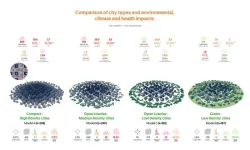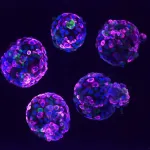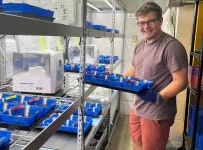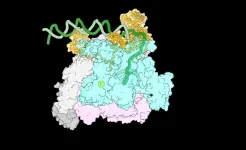An innovative test to diagnose chagas disease in newborns
The LAMP molecular diagnostic test, coupled with a modified 3D printer to extract DNA, has a sensitivity comparable to PCR, and can be used in laboratories with limited resources
2024-07-04
(Press-News.org)
An innovative test that combines a DNA extraction system inspired by a modified 3D printer (PrintrLab) with loop-mediated isothermal molecular amplification (LAMP) could be used to detect T. cruzi infection -responsible for Chagas disease- in newborns. This is the conclusion of a proof-of-concept study conducted in the Bolivian Chaco, an endemic area for Chagas disease. The study was coordinated by the Barcelona Institute for Global Health (ISGlobal), a centre supported by "la Caixa" Foundation, in collaboration with the CEADES Foundation (Bolivia), CONICET-INGEBI (Argentina), AI Biosciences (USA), FIND (Switzerland) and the Mundo Sano Foundation (Argentina).An innovative test that combines a DNA extraction system inspired by a modified 3D printer (PrintrLab) with loop-mediated isothermal molecular amplification (LAMP) could be used to detect T. cruzi infection -responsible for Chagas disease- in newborns. This is the conclusion of a proof-of-concept study conducted in the Bolivian Chaco, an endemic area for Chagas disease. The study was coordinated by the Barcelona Institute for Global Health (ISGlobal), a centre supported by "la Caixa" Foundation, in collaboration with the CEADES Foundation (Bolivia), CONICET-INGEBI (Argentina), AI Biosciences (USA), FIND (Switzerland) and the Mundo Sano Foundation (Argentina).
Twenty percent of new cases of Chagas disease are due to vertical (or congenital) transmission. This occurs when an infected mother passes the parasite to her baby during pregnancy. Early detection of the parasite in women and newborns is therefore a public health priority. The problem is the lack of simple, rapid and reliable tests. In high-income countries like Spain, newborn diagnosis can be done by PCR, but this is an expensive method that requires skilled personnel. In endemic regions, up to two microscopy tests are performed (at birth and at two months), which have low sensitivity and must be followed several months later by a serological test to detect antibodies to the parasite. The number of tests and the time lag between them increases the risk that children will not receive the treatment they need.
"In endemic regions, it would be very useful to have a simple, rapid and sensitive test to detect the parasite in newborns, when treatment is most effective," explains Julio Alonso Padilla, researcher at ISGlobal.
More sensitive than microscopy
In this study, a team led by Alonso-Padilla evaluated an innovative diagnostic test that combines a simple molecular amplification technique (LAMP) developed by the Japanese company Eiken, with a 3D printer modified to extract DNA from a small blood sample (PrintrLab). The results were compared with those of PCR and the "standard" diagnostic methods (microscopy and serology).
The study included 224 infants born to T. cruzi seropositive mothers and followed for eight months. A total of 23 cases of congenital transmission were detected (nine by microscopy at birth and a further 14 by serology eight months later). LAMP was able to detect 13 of the 23 cases early on (i.e. four additional cases to those detected by microscopy), and PCR was able to detect 14 of the 23 (five additional cases).
"This shows that the sensitivity of PrintrLab-LAMP is higher than that of microscopy and almost equal to that of PCR," says Alonso-Padilla. The advantage is that PrintrLab should be cheaper than PCR and requires minimal infrastructure.
Following the country’s guidelines for diagnosis and treatment of congenital Chagas disease, all infected newborns were treated and cured, highlighting the importance of early detection and treatment.
The research team points out that this was a proof of concept to demonstrate the feasibility of the PrintrLab-LAMP test, and that it now needs to be tested on a larger scale and in a larger number of centres. If its potential is confirmed, the test could also be useful for detecting acute infections in adults, or assessing the effectiveness of treatment.
Reference
Rojas L, Rivera S, Wehrendt DP et al. Evaluation and validation of a PrintrLab-based LAMP assay to identify Trypanosoma cruzi in newborns in Bolivia: a proof of concept study. Lancet Microbe, doi: 10.1016/S2666-5347(24)00110-1.
END
ELSE PRESS RELEASES FROM THIS DATE:
2024-07-04
What types of cities exist in Europe and which are more favourable in terms of human health, environmental quality and carbon footprint? To answer these questions, a study led by the Barcelona Institute for Global Health (ISGlobal), a centre supported by the "la Caixa" Foundation, has analysed 919 European cities. The research, published in The Lancet Planetary Health, identified four basic urban configurations on the continent: compact-high density cities, open lowrise-medium density cities, open lowrise-low density cities and green-low density cities. The results show that greener and less densely populated ...
2024-07-04
Reducing consumption of processed meat by around one-third could prevent more than 350,000 cases of diabetes in the US over 10 years, a study suggests.
Cutting US adults’ processed meat intake by 30 per cent – the equivalent of around 10 slices of bacon a week – would also lead to tens of thousands of fewer cases of cardiovascular disease and colorectal cancer, researchers say.
A team from the University of Edinburgh’s Global Academy of Agriculture and Food Systems together with the University of North Carolina, Chapel Hill, has developed ...
2024-07-04
Stem cell-based embryo models (SCBEMs) are three-dimensional biological structures that mimic aspects of early human embryo development. They can be created in the lab from stem cells, and can provide new insights into critical stages of early human development that are normally inaccessible to researchers.
Embryo model work is expected to lead to new interventions for a range of conditions, including revolutionising treatments for recurrent miscarriage, understanding developmental disorders and improving the success rate of IVF.
Although embryo models are not the same ...
2024-07-04
Tampons from several brands that potentially millions of people use each month can contain toxic metals like lead, arsenic, and cadmium, a new study led by a UC Berkeley researcher has found.
Tampons are of particular concern as a potential source of exposure to chemicals, including metals, because the skin of the vagina has a higher potential for chemical absorption than skin elsewhere on the body. In addition, the products are used by a large percentage of the population on a monthly basis—50-80% of those who menstruate use tampons—for several hours at a time.
“Despite this large potential for public health concern, very little research ...
2024-07-03
Researchers at Rice University are making strides in understanding how chromosome structures change throughout the cell’s life cycle. Their study on motorized processes that actively influence the organization of chromosomes was published in the Proceedings of the National Academy of Science.
“This research provides a deeper understanding of how motorized processes shape chromosome structures and influence cellular functions,” said Peter Wolynes, study co-author and the D.R. Bullard-Welch Foundation Professor of Science. ...
2024-07-03
Rice University chemist Han Xiao has been awarded nearly $2 million from the National Institutes of Health Maximizing Investigators’ Research Award (MIRA) program for established investigators.
All organisms with few exceptions use 20 standard amino acids to build proteins. Xiao’s research aims to reprogram the genetic code to precisely manipulate biological systems by using noncanonical amino acids (ncAAs) with diverse properties to help build proteins. Researchers generally use ncAAs to investigate the structure and dynamics of proteins, but Xiao wants to take that a step further.
“This innovative approach could revolutionize how ...
2024-07-03
Swedish researchers have created a questionnaire test for home use that quickly identifies high risk of heart attack. A study shows that it has the same level of accuracy as blood tests and blood pressure measurements.
The study, published in Journal of the American Heart Association, uses data from the SCAPIS population study, which is based at the University of Gothenburg, with the Swedish Heart Lung Foundation as its main sponsor.
The study was led by Göran Bergström, Professor of Clinical Physiology at Sahlgrenska Academy at the University of Gothenburg, senior ...
2024-07-03
Researchers from the Butantan Institute and collaborators are developing a more potent version of the BCG vaccine that protects against tuberculosis. While the conventional immunizer reduced infection by 90% in experiments with mice, the so-called recombinant BCG increased the protection rate to 99%. In addition, the new formulation protected the animals for a significantly longer period of time.
“BCG is the first vaccine we receive at birth, and it’s indeed effective in protecting children. But immunity against the disease tends to wane in adulthood, and as bacteria are becoming resistant to antibiotics, no ...
2024-07-03
URBANA, Ill. – Urban agriculture has the potential to improve food security through local, efficient, and sustainable food production. Examples of urban food systems include hydroponics, where plants grow in a nutrient solution without soil, and aquaponics, which combines hydroponics with raising fish in tanks.
A new study from the University of Illinois Urbana-Champaign examines the use of aquaponics wastewater as a growth medium for lettuce in a hydroponic system. This practice can potentially ...
2024-07-03
Every living cell transcribes DNA into RNA. This process begins when an enzyme called RNA polymerase (RNAP) clamps onto DNA. Within a few hundred milliseconds, the DNA double helix unwinds to form a node known as the transcription bubble, so that one exposed DNA strand can be copied into a complementary RNA strand.
How RNAP accomplishes this feat is largely unknown. A snapshot of RNAP in the act of opening that bubble would provide a wealth of information, but the process happens too quickly for current technology to easily capture visualizations ...
LAST 30 PRESS RELEASES:
[Press-News.org] An innovative test to diagnose chagas disease in newborns
The LAMP molecular diagnostic test, coupled with a modified 3D printer to extract DNA, has a sensitivity comparable to PCR, and can be used in laboratories with limited resources







